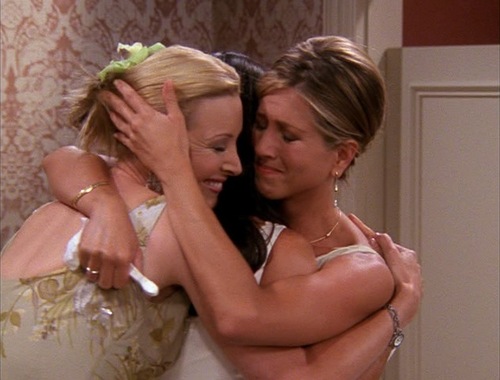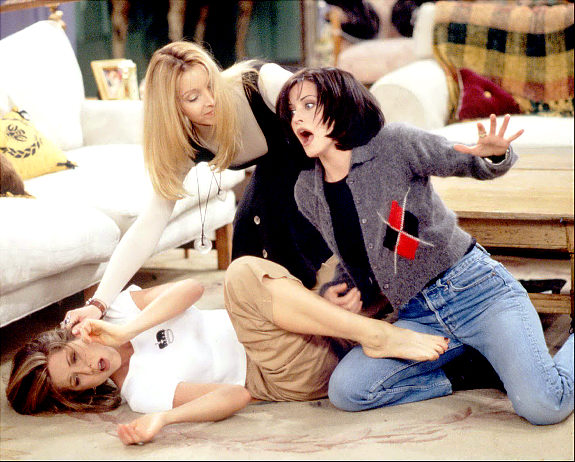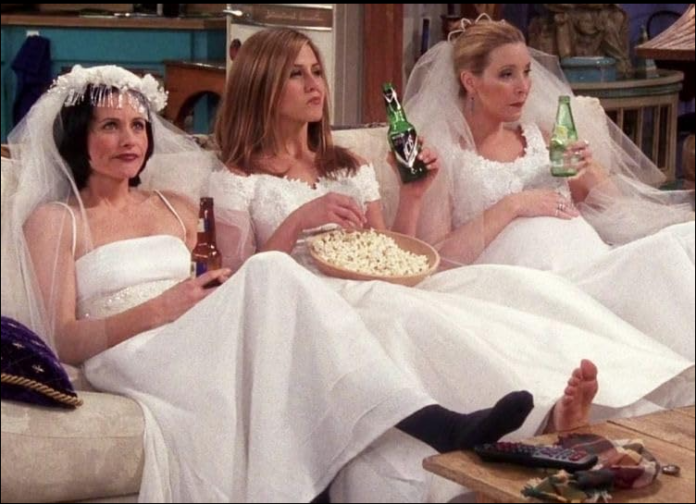Before Hannah Horvath ever envisioned indulging in cupcakes while sharing a bath with her best friend, or Carrie Bradshaw waxed eloquent about her love for shoes and her colorful sex life, there were three women seated in a coffee shop lamenting their seemingly futile jobs, financial struggles, and lackluster love lives.
These women happened to be Rachel Green, Monica Geller, and Phoebe Buffay, representing the female contingent of the Friends ensemble. While their show wasn’t specifically designed with the goal of portraying the world through a female perspective, they left a lasting cultural impact on women both on and off the screen.
Friends aired from 1994 to 2004 on NBC, and it became synonymous with the network’s Must-See TV era. It’s one of the rare television series that can be credited with defining an entire generation.
Approach any Gen X individual and shout “Pivot!” at them, and you’ll either receive a grin or a grimace, but in either case, they’ll understand what you’re referring to. By blending the aimlessness often associated with the twentysomething experience with the comforting concept of a chosen family, Friends not only mirrored the times but also played a significant role in shaping them.
From the iconic Rachel haircut to Joey Tribbiani’s foolproof pick-up line, “How you doin’?” becoming part of popular language, the show’s influence permeated the culture. Given how deeply the series embedded itself in the cultural landscape, it’s no surprise that its core female trio resonated with female viewers, and not just in terms of fashion.
When considered collectively, it’s clear that the characters on Friends didn’t encompass a comprehensive cross-section of the female experience in the 1990s. Regrettably, much like its successors Sex and the City and Girls, Friends fell short regarding racial diversity.
The experience it portrayed was undoubtedly white and middle-class. Nevertheless, the show succeeded in setting apart its three female leads by endowing each of them with distinctive personality traits and qualities.
Monica and Rachel shared similar economic backgrounds, having grown up together, but they occupied different ends of the high school social hierarchy. At the start of the series, Rachel embodied the archetypal head cheerleader stereotype, with her future seemingly destined to include a life of luxury as a doctor’s pampered wife.
In contrast, Monica lacked Rachel’s popularity in high school and grappled with body image and control issues stemming from her childhood and teenage years as an overweight individual.

Monica’s struggles ultimately contributed to her developing greater self-confidence than Rachel and better equipped her to handle the challenges of adulthood.
In fact, it’s Rachel’s relative helplessness in the real world that serves as the series’ starting point, as she reenters Monica’s life as a runaway bride in search of refuge.
Rachel: Oh… well, it started about a half hour before the wedding. I was in the room where we were keeping all the presents, and I was looking at this gravy boat. This really gorgeous Lamauge gravy boat. Then, all of a sudden, I realized that I was more turned on by this gravy boat than by Barry! And then I got really freaked out, and that’s when it hit me: how much Barry looks like Mr. Potato Head. Y’know, I mean, I always knew he looked familiar, but… Anyway, I just had to get out of there, and I started wondering, why am I doing this, and who am I doing this for? So anyway, I just didn’t know where to go, and I know that you and I have kind of drifted apart, but you’re the only person I knew who lived here in the city.
Monica: Who wasn’t invited to the wedding?
Phoebe truly stood out as the outlier among the Friends characters. She didn’t belong to the middle class or come from a conventional nuclear family background. Her early adulthood was marred by her mother’s tragic suicide and a period of living on the streets of New York during her teenage years.
While these darker aspects of her life often served as comedic material, a substantial portion of Phoebe’s journey throughout the ten-year series revolved around her quest to uncover her past.
Also read, Review: Hill Street Blues, “Blood Money” and “The Last White Man on East Ferry Avenue.”
She sought answers about her parentage and assumed a surrogate role for her half-brother and his older wife. In a series centered on the idea of the families we create, Phoebe spent a significant amount of time searching for the family she was born into.
During the early years, most of Phoebe’s time was dedicated to her musical pursuits and embracing New Age spirituality. While all the characters on the show underwent some degree of growth throughout the series, Phoebe’s character development was particularly noteworthy.
Initially, she was portrayed as a spacey, somewhat ditzy caricature, embodying the sitcom stereotype of a vegetarian and a hippie rather than a fully fleshed-out individual. However, with each passing season, Phoebe’s character evolved.
Her strong beliefs ceased to be a subject of mockery and instead became an integral part of what made her unique. Additionally, she shed the ditziness and cultivated a strong sense of self, transforming her into a consistent voice of reason within the group.
Certainly, Friends wasn’t solely centered around female-driven narratives. Its core storyline revolved around the dynamics between the female characters and the show’s male trio: Ross Geller (Monica’s older brother and Rachel’s occasional boyfriend), Chandler Bing (who would eventually become Monica’s husband), and Joey.
In a post-When Harry Met Sally era, Friends initially presented an authentic counterargument to the notion that men and women can’t maintain purely platonic friendships.
However, by the series’ conclusion, nearly every character, except those who were related or named Phoebe, had been romantically involved with one another (even Monica and Ross shared a kiss).
Nevertheless, in the early seasons, the group maintained a refreshingly platonic dynamic, aside from Ross and Rachel’s recurring “we were on a break!” drama.
Rather than centering its storytelling on unresolved sexual tension within the group, Friends channeled its creative energy into crafting an engaging and entertaining hang-out show.
In contrast to its contemporary, Seinfeld, Friends never positioned itself as a show about nothing, but it also didn’t aim to be a sitcom with a specific message or statement to convey.
While Friends didn’t actively address the political landscape of its time, it might seem paradoxical to assert that Monica, Rachel, and Phoebe embodied the emerging third-wave feminist movement of the early ’90s.
However, the show managed to achieve this feat. Each of these characters was characterized by their individualism and an open attitude towards their sexuality.
They all desired stable and committed relationships, but this didn’t deter them from dating and engaging with multiple sexual partners (while also being unapologetic about it, albeit not typically using the language of conquest commonly associated with their male counterparts).
For instance, in episode 10, “The One with the Monkey,” Rachel remarks to Phoebe regarding her new boyfriend’s approach to their relationship:
Rachel: Pheebs, I can’t believe he hasn’t kissed you yet. I mean God, by my sixth date with Paolo, he had already named both my breasts! …Ooh. Did I just share too much?
It’s undeniable that a significant portion of Rachel, Monica, and Phoebe’s narratives revolved around their romantic relationships with men. In this respect, Friends’ legacy can be viewed as problematic.
Many series that have attempted to emulate the Friends formula have often used their female characters primarily as conduits for romantic storylines, with How I Met Your Mother being a notable example that received critical acclaim.

Unfortunately, these shows often miss the broader depth of Monica, Rachel, and Phoebe’s characterizations. While all three ultimately ended up in heteronormative relationships, they were never exclusively defined by their romantic partners.
Rachel’s journey can be seen as the purest coming-of-age tale, starting the series as a waitress with no clear direction in life and concluding it as a successful businesswoman and mother. Throughout the series, Rachel consistently prioritized her career, taking immense pride in her personal growth.
Similarly, Monica’s unwavering passion for cooking remained one of her defining qualities throughout the show’s duration. In season nine, she even opted for a position at a prestigious restaurant over uprooting her life to move to Tulsa when Chandler’s job required a relocation.
Phoebe, on the other hand, didn’t exhibit the same level of passion for her career as a massage professional; instead, her true passion was reserved for her music (despite its questionable quality).
While Friends certainly had its flaws, it undeniably portrayed its female characters positively, even as it adhered to more traditional storylines for each of them.
The show never explicitly tackled issues of women’s representation, but it skillfully crafted engaging stories centered around its female characters, covering topics ranging from work and relationships to friendships, all of which resonated with a broad audience.
Strong female friendships are a rarity on television, which makes the bonds between the women of Friends even more significant. Season Six, “The One on the Last Night,” showcased Rachel and Monica’s friendship as they prepared for Chandler to move in with Monica and for Rachel to move out.
Throughout the episode, the two women engage in playful banter before ultimately confessing the myriad reasons why they’ll miss living together. The episode reaches an emotional peak when Monica tearfully exclaims, “And now you have to leave, and I have to live with a boy!”
Their friendship bore striking similarities to the bonds forming among real aimless twentysomethings embarking on their journey into adulthood during the Clinton era.

Even today, asking someone if they identify as a “Rachel,” a “Phoebe,” or a “Monica” can serve as a useful gauge for understanding their personality.
Friends succeeded not because it was groundbreaking but because it struck a deep emotional chord.
Its aim wasn’t to dissect culture; rather, it aimed to be a part of it. In doing so, the series crafted three female characters who, despite their flaws, felt as genuine as the friend sitting beside you while you both enjoyed your favorite fictional Friends sipping coffee.


